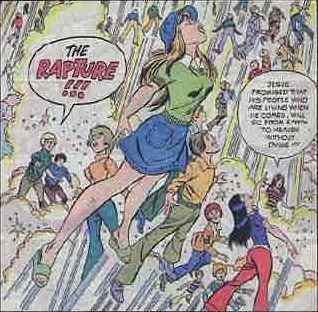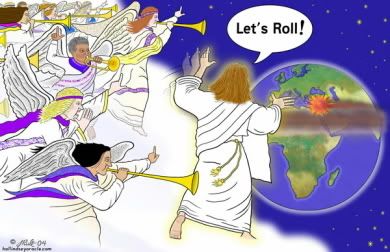
In Sunday School today, we talked about conceptions and misconceptions relating to the eschatology, that is the study of things related to the end. Btw, next week we'll look at apocalyptic texts and the week after, we'll look at the "four last things": death, judgment, heaven, and hell.
One topic we touched on today was the popular teaching about the rapture of the church (that was under the category of misconception, of course). The rapture teaching goes back to the mid 1800s, popularized by John Nelson Darby at various bible prophecy conferences and then by dispensationalism as represented in the Scofield Reference Bible.
The idea of the rapture of the church is that sometime before the Second Advent of Jesus, the Lord comes secretly to remove the church from the earth--the last resistance to evil in the world. It's what we described in class as "Advent 1.5"--Jesus passes by just close enough to pick up his friends before things get really bad. Unfortunately, the teaching dogmatizes escapism and sometimes ends up producing a strange perspective on the world, as seen on wesites like raptureready.com.
Of course, scripture reference are used to support this teaching, but as we studied today, each passage has to be used very selectively in order to fit, sometimes even requiring new doctrines to make it fit (e.g., a new secret resurrection of raptured believers before the general resurrection). Two passages commonly used in support of the rapture (apart from other "last day", second coming, and general resurrection passages) are 1 Thessalonians 4:13-18 and Matthew 24:37-41.
The letter to the Thessalonians was perhaps the earliest written part of the New Testament. The believers at Thessalonica expected the Lord's return soon, but some in their church had died and they were concerned that those departed brethren might miss out on this great event. Paul writes to them and says don't worry; they won't miss a thing. At first glance, it sounds like a description of the rapture (indeed, this passage is where the word "rapture" comes from in the Latin translation). Verse 17: "We who are alive, who are left, will be caught up together with them [i.e., the resurrected dead] in the clouds to meet the Lord in the air, and so we will always be with the Lord."
But there are problems. As mentioned before, to make the rapture fit, we now need a secret resurrection of departed believers, separated in time, before the general resurrection takes place. In the rapture view, life continues as it was on earth, but with all the Christians missing (at least the true believers). Also, the event described in this passage is not so secret; it is heralded with trumpet blasts and shouts of praise. Verse 16: "For the Lord himself will descend from heaven with a cry of command, with the voice of an archangel, and with the sound of the trumpet of God."
This is of course, an exact description of the traditional view of the Second Coming of Jesus--in power and glory, public and heralded for all the world to see and hear, instantaneous, momentous, and unmistakable. There is no secret advent envisioned in this passage. Along with the Second Coming of Christ, the dead are raised to stand for judgment. The believers rise "first" to go out and meet the Lord, to welcome him as he arrives with the saints and angels. This is the cultural way of greeting an arriving dignitary in biblical times.
It was for this reason that the Matthean Palm Sunday passage used to be read on the first Sunday in Advent. The version in John's gospel shows that practice best: "The next day the large crowd that had come to the feast heard that Jesus was coming to Jerusalem. So they took branches of palm trees and went out to meet him, crying out, 'Hosanna! Blessed is he who comes in the name of the Lord, even the King of Israel!'" (John 12:12-13).
In Matthew 24:37-41, Jesus gives a description of the end times. Jesus tells the disciples that no one can know the time of the end, but you can heed the warning signs. This has the familiar quote in verse 40-41: "Then two men will be in the field; one will be taken and one left.
However, context is everything. The context is that Jesus is describing the last day--the final judgment or "Day of the Lord." And he describes it by the analogy of a previous divine judgment--the great deluge of Noah's time. Verse 27-39:
In context, the sinners are "swept away" and the righteous are "left behind."
Make no mistake, you want to be left behind!

View the above cartoon and others by John Rule at the Hal Lindsey Oracle Cartoons website.


No comments:
Post a Comment